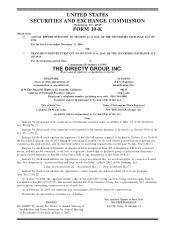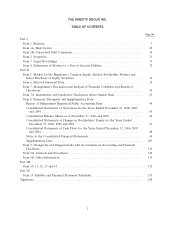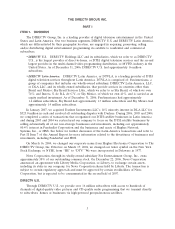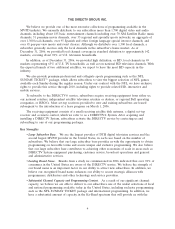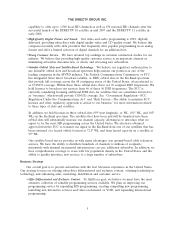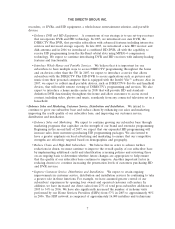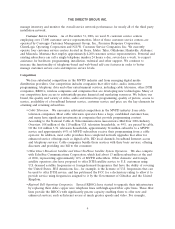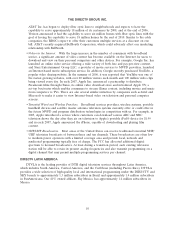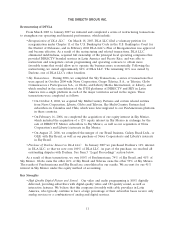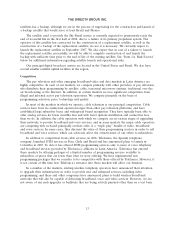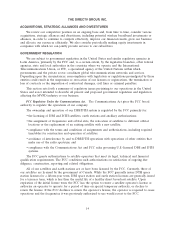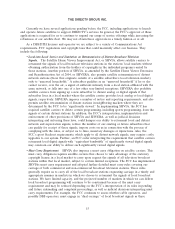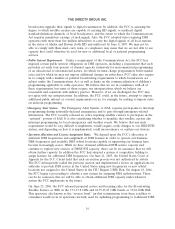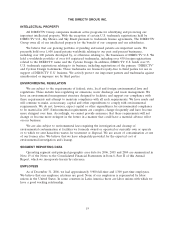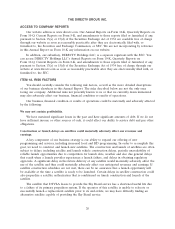DIRECTV 2006 Annual Report Download - page 21
Download and view the complete annual report
Please find page 21 of the 2006 DIRECTV annual report below. You can navigate through the pages in the report by either clicking on the pages listed below, or by using the keyword search tool below to find specific information within the annual report.THE DIRECTV GROUP, INC.
AT&T Inc. has begun to deploy fiber optic lines to neighborhoods and expects to have the
capability to serve approximately 18 million of its customers by 2008, and at the end of 2006,
Verizon announced it had the capability to serve six million homes with fiber optic lines with the
goal of having the capability to serve 18 million homes by the end of 2010. Similar to the cable
companies, the RBOCs expect to offer their customers multiple services at a discount on one
bill. AT&T recently acquired BellSouth Corporation, which could adversely affect our marketing
relationship with BellSouth.
•Video via the Internet. With the large increase in the number of consumers with broadband
service, a significant amount of video content has become available on the Internet for users to
download and view on their personal computers and other devices. For example, Google Inc. has
launched an online video service offering a wide variety of both free and pay-per-view content,
and Starz Entertainment Group LLC, a provider of movie services to MVPD providers, launched
an Internet-based movie subscription service. In addition, Google recently purchased YouTube, a
popular video sharing website. In the summer of 2006, it was reported that YouTube was one of
the fastest growing websites, with over 20 million visitors each month and 100 million video clips
being viewed every day. In early 2007, Apple Inc. announced a partnership to distribute
Paramount films through iTunes, its online video download store and introduced Apple TV, a
set-top box/router which enables consumers to stream iTunes content, including movies and music
from computers to TVs. There are also several similar initiatives by companies such as Intel and
Microsoft to make it easier to view Internet-based video on television and personal computer
screens.
•Terrestrial Wired and Wireless Providers. Broadband services providers, wireless systems, portable
handheld devices and satellite master antenna television systems currently offer or could offer in
the future MVPD and program distribution technologies in competition with us. For example, in
2005, Apple introduced a service where customers can download various ABC and NBC
television shows the day after they air on television to Apple’s portable iPod device for $1.99
and in early 2007, Apple announced the iPhone, capable of downloading and playing film
content.
•VHF/UHF Broadcasters. Most areas of the United States can receive traditional terrestrial VHF/
UHF television broadcasts of between three and ten channels. These broadcasters are often low
to medium power operators with a limited coverage area and provide local, network and
syndicated programming typically free of charge. The FCC has allocated additional digital
spectrum to licensed broadcasters. At least during a transition period, each existing television
station will be able to retain its present analog frequencies and also transmit programming on a
digital channel that may permit multiple programming services per channel.
DIRECTV LATIN AMERICA
DTVLA is the leading provider of DTH digital television services throughout Latin America,
which includes South America, Central America, and the Caribbean (including Puerto Rico). DTVLA
provides a wide selection of high-quality local and international programming under the DIRECTV and
SKY brands to approximately 1.3 million subscribers in Brazil and approximately 1.4 million subscribers
in PanAmericana. Our 41% owned affiliate, Sky Mexico, has approximately 1.4 million subscribers in
Mexico.
10


